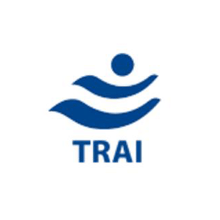Telecom Regulatory Authority of India
 | |
| Regulatory agency overview | |
|---|---|
| Formed | 20 February 1997 |
| Jurisdiction | India |
| Headquarters | Mahanagar Doorsanchar Bhawan, Jawaharlal Nehru Marg (Old Minto Road), New Delhi |
| Regulatory agency executives |
|
| Key document | |
| Website |
www |
The Telecom Regulatory Authority of India (TRAI) is a statutory body set up by the Government of India under section 3 of the Telecom Regulatory Authority of India Act, 1997. It is the regulator of the telecommunications sector in India.[2] It consists of a Chairperson and not more than two full-time members and not more than two part-time members.
History
Telecom Regulatory authority of India was established on 20 February 1997 by an Act of Parliament to regulate telecom services and tariffs in India. Earlier regulation of telecom services and tariffs was overseen by the Central Government. The current Chairman of TRAI is Mr. Ram Sewak Sharma.
TRAI's mission is to create and nurture conditions for growth of telecommunications in India to enable the country to have a leading role in the emerging global information society.[3]
One of its main objectives is to provide a fair and transparent environment that promotes a level playing field and facilitates fair competition in the market. TRAI regularly issues orders and directions on various subjects such as tariffs, interconnections, quality of service, Direct To Home (DTH) services and mobile number portability .
In January 2016, TRAI introduced an important change in telecommunication that would benefit all consumers. Effective from 1 January 2016, consumers will be compensated for call drops. However, there is a catch, per the rule, mobile users will get a compensation of Re 1 for every dropped call but it will be limited to a maximum three dropped calls in a day. This regulation has been quashed by Supreme Court on the ground of being "unreasonable, arbitrary and unconstitutional".[4]
Secretariat
TRAI is administered through a Secretariat headed by a secretary. All proposals are processed by the secretary, who organizes the agenda for Authority meetings (consulting with the Chairman), prepares the minutes and issues regulations in accordance to the meetings. The secretary is assisted by advisors. These include Mobile Network, Interconnection and Fixed Network, BroadBand and Policy Analysis, Quality of Service, Broadcasting & Cable Services, Economic Regulation, Financial Analysis & IFA, Legal, Consumer Affairs & International Relation and Administration & Personnel. Officers are selected from the premier Indian Telecommunications Service and also from the Indian Administrative Service.[5]
TRAI Mobile Apps
On 06 June 2017, TRAI launched three new apps and a web portal to ensure that the Indian users are fully aware of the telecom services that are being offered to them.
Mycall app, MySpeed app and 'Do not disturb (DND 2.0)' apps are now going to educate and ensure that there is transparency - between what consumers are actually paying for and what telecom operators are promising to provide at a certain rate.
Recent TRAI initiatives
In order to increase broadband penetration in India, TRAI has proposed WANI (Wi-Fi Access Network Interface) architecture. If implemented, it may lead to set up of Public Data Offices (PDOs) where Wi-FI Internet would be available on demand. TRAI relates the same with PCOs which were used to do the voice calls and were very popular hotspots before the mobile phones or home landlines became the ultimate mode of communication.[6]
See also
References
- 1 2 3 ""TRAI Whos Who"".
- ↑ "The Telecom Regulatory Authority of India Act, 1997 — The Centre for Internet and Society". Cis-india.org. Retrieved 2016-08-18.
- ↑ "Dropped calls may earn you Re 1 compensation - The Economic Times". Economictimes.indiatimes.com. 2015-10-16. Retrieved 2016-08-18.
- ↑ "SC strikes down 'arbitrary, unconstitutional' call drop penalty". Moneycontrol.com. 2016-05-11. Retrieved 2016-08-18.
- ↑ "TRAI Manual" (PDF).
- ↑ "WANI Network Architecture Proposal for TRAI Public Data Office (PDO) - Techplayon". Techplayon. 2017-08-07. Retrieved 2018-09-13.